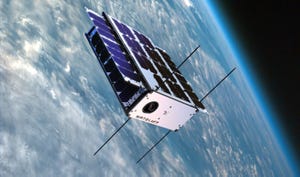
SpaceX Launch Begins Startup's Plan for 'Cell Towers in Space' - CNET
With a SpaceX rocket launch set for late Monday, a Spanish company called Sateliot expects to take its first step toward giving you text messaging abilities in remote parts of the world where conventional mobile networks fail.
The 50-employee Barcelona-based startup is one of a growing number of attempts to use satellites about 310 miles above our heads in low Earth orbit to bring us closer to the promise of ubiquitous connectivity. With Apple, Verizon, T-Mobile and Qualcomm all headed in the same direction, it seems likely that, in the near future, stranded motorists and injured hikers won’t be so isolated.
Satelliot’s launch, from the Vandenberg Space Force Base in California, is expected to carry the first of five satellites into orbit this year, enough to get the first phase of Sateliot’s business up and running. Next year, the company plans to have 64 satellites in orbit, then 256 satellites in 2025. That’ll be enough to enable text message conversations, he said.
“We are the cell tower in space for the mobile operators,” Sateliot Chief Executive Jaume Sanpera said in an exclusive interview. “These are small satellites — nano satellites — that allow us to have coverage everywhere in near real time in three years.”
Sateliot is not alone in its ambition to use data links that hop across the heavens. Here are some of the other players:
Locating local internet providers
- Apple’s iPhone 14 Pro models introduced in 2022 come with a satellite SOS feature that uses GlobalStar satellites to send text messages to your emergency contact.
- T-Mobile plans to use SpaceX’s Starlink satellites to reach dead zones in “select areas” by the end of 2023.
- Smartphone chip giant Qualcomm revealed plans to fire up its Snapdragon Satellite service in the second half of 2023 thanks to 66 Iridium satellites. That should start with emergency messages but expand to regular ones.
- Verizon plans to use Amazon’s Project Kuiper satellite constellation to link not to individual phones, but to cell towers in remote locations that otherwise couldn’t be practically linked to the internet.
With Sateliot’s technology, you’ll never know you’re using their service. Your phone will simply connect to its satellites through carrier partnerships.
Although the company’s longer-term plan is to help consumers, that’s not where it’s starting. Instead, with its five-satellite constellation this year, it plans to connect companies in fields like logistics and maritime shipping, Sanpera said. It’s signed three deals worth a total of about $1.1 billion to enable such services.
Each satellite can communicate with a patch of Earth about three times the size of Texas as it whizzes overhead. With the small initial constellation, Sateliot can guarantee a satellite connection once a day. Because the device on the planet knows when satellites will be overhead, it can wake up to communicate and spend the rest of its hours slumbering in a low-power state. That means batteries will last years.
Some communications satellites are enormous, like a bus-sized Hughes communication satellite that SpaceX is set to launch in coming weeks, but Sateliot’s first models are much smaller: about 4 by 8 by 12 inches, or about the size of a big cereal box that’s called a 6-unit or 6U cubesat. Next year’s satellites will be double the thickness, with a 12U design.
Thanks to electronics miniaturization, though, these small systems can be powerful. And that’s why there’s something of a new space race afoot, this time among tech companies instead of political superpowers.
“People want to have messaging everywhere,” Sanpera said.

